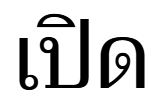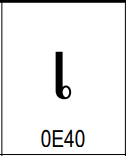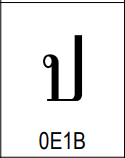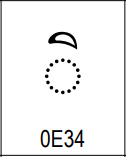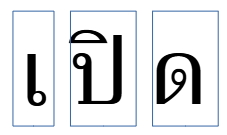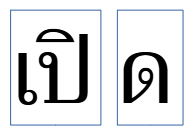paasaathai is a Go module with linguistic functions for parsing and analyzying written Thai language. It is a work in progress and the API and functionality is constantly changing.
The module provides different pieces of functionality.
This module can parse UTF-8 Thai text and produce objects called GraphemeStacks. A single user-perceived Thai "character" can have multiple individual graphemes in it. It might have "diacritic" vowels either above or below the consonant. It might have a tone mark. And there a few other things too.
In this example, the word "bperd" ("to close") is shown as a single word:
But it is composed of 4 separate Unicode code points, as per the Unicode codepoint documentation for Thai:
But two of the Unicode codepoints are in the same horizontal space, one stacked vertically on top of the other. In this module, these vertically-stacked graphemes are called GraphemeStacks. Here are the 3 individual GraphemeStacks in this word:
There are Thai orthography rules that treat some sequences of Thai graphemes as complete, unbreakable units. The article, Character Cluster Based Thai Information Retrieval by Thanaruk Theeramunkong, Virach Sornlertlamvanich, Thanasan Tanhermhong, and Wirat Chinnan, call these "Thai Character Clusters".
Most of these clusters are created from how some vowels are written as multi-character sequences. In this example, you see the same word, "bperd", broken up into 2 clusters of grapheme stacks, or GStackClusters.
The front character, a vowel, must be followed by a consonant. They, they form a cluster. Note that these clusters are not syllables; they are not units of sound. They are simply an artifact of the rules of orthography. In this example, the final character stands alone as a cluster by itself.
